Hauntology's Space Between The Two Deaths: Machine In The Ghost Revisited
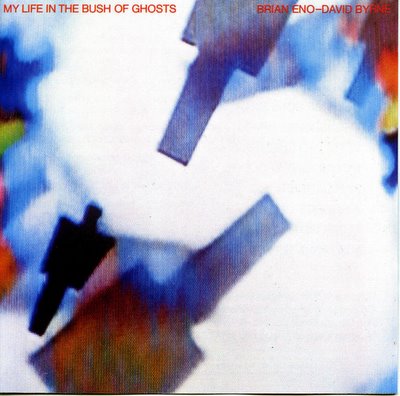
Jacques Derrida's Spectres of Marx suggests that the ghost or specter haunts because it has come undone from time: it haunts from the past and the future. However if Derrida's version of the ghost is that of a paradoxically-embodied voice "out of joint" in time and space, Zizek's model is that of the Lacanian "barred subject" - a subject structurally "out of joint." The Lacanian model supposes a subject structured around an irrepresentable-impossible kernel, the Real, to which it cannot have access, instead anamorphically accessing "reality" through the work of "fantasy" - not a sustained illusion, but the way through which we structure reality ["truth has the structure of fiction"]. Zizek's claim, like Derrida's, is that now more than ever we find ourselves in a world of increasing virtualization, as it has always been. For Zizek, we are surrounded by a "plague of fantasies" - pseudo-concrete images which cover over the mounting abstractions at work in our lives. However, the very way in which we structure our reality through the work of fantasy suggests that fantasy and materiality are mutually constitutive. Zizek argues that "the materialization of ideology in external materiality reveals inherent antagonisms which the explicit formulation of ideology cannot afford to acknowledge" - in other words, our material cultural productions (from television ads to our very subjectivity) reveal the antagonism underlying ideology. In this model, fantasy is not only a social mechanism for covering over the unrepresentability/horror of the impossible Real, but also in some senses creates or points to that horror. So, in opposition to the usual claim that fantasy creates a narrative which covers over - quilts, sutures, hegemonizes - makes a whole of existence, Zizek is arguing that fantasy consistently comes undone, falls apart - "the truth is out there," embedded materially, right alongside the fantasy, not hidden.
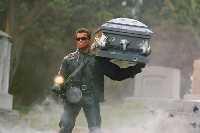
Consider, then, Zizek's analysis of two mirror-image ways in which the fantasy comes undone: what he calls "the ghost in the machine" and the "machine in the ghost." Zizek argues that the categories we know as "life" and "death" are supplemented/underpinned by two other categories: the horror of the machine in the ghost and the ghost in the machine, between which the Death Drive is located. These two categories Zizek sees as undermining the difference between life and death, the material and the immaterial, in such a way that we are forced to confront the horror that we might be both alive and dead at the same time.

"The machine in the ghost" is the discovery that what appears to be alive is actually dead - a doll or robot made to look like a living human, a machine of gears that sits in a technological graveyard, industrial and urban ruins: "this is the ultimate horror: not the proverbial ghost in the machine but the machine in the ghost: there is no plotting agent behind it, the machine just runs by itself, as a blind contingent device". Zizek ties this image in to language - the dead symbolic order which behaves as if it is alive but ultimately is a cold machine.

Conversely, "the ghost in the machine" is the ghastly supplement of flesh, the zombie body, the Monster Life-Thing, the "acephalous" slime, life where there should be none - "the monstrous Life-substance that persists in the Real outside the symbolic". What Freud and Lacan called the Death Drive exists between these two machine deaths - "death in the symbolic and death in the Real". Life and death thus become confused, sitting supplemented by the "symbolic parasitic machine" or "blind contingent device" and the living dead.
Veronique, Puppet of Hauntology?
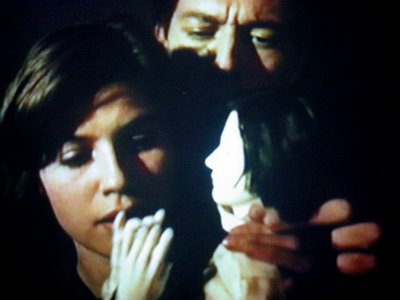
Polish film director Krzysztof Kieslowski's masterpiece, The Double Life of Veronique, begins with Weronika, a Polish girl whose bell-like voice seems to be a ticket to operatic fame. Weronika, however, suffers from a heart condition. She has to choose - continue singing with all the strain and stress which this involves and risk her life, or give up her singing career to lead a normal life. She wins a singing contest and chooses her career. During a concert she suffers a heart attack and dies. At the same moment, Veronique, a French girl of exactly the same age, a perfect double of the Polish Weronika, decides to give up her singing career and thus "cheats fate" of a parallel death. It is as if Weronika has "returned" to correct her original misstep, the choice that led to her death.

Veronique is Weronika's double. She, too, has a beautiful voice and a heart condition. But without knowing it, she shares Weronikas's wisdom. When Weronika suffers, Veronique senses that she must avoid the situation which leads to the pain. Veronique rejects her singing career and teaches music at a primary school. One day, Alexandre, a puppeteer and story writer, visits her school. She is entranced by him and reads the books he has written. Days later she receives mysterious messages - an empty cigar box, a shoe lace, a cassette recording of various sounds made in a station cafe. She finds the station cafe and sees Alexandre waiting for her. In the hotel room where they make love, Alexandre finds the photographs which Veronique took when she visited Poland. He sees Weronika, thinking it's Veronique. It is only now that Veronique realizes that she has, or had, a double. She feels that Alexandre is her fate but her illusion is shattered. Alexandre makes two puppets, one of Veronique, the other, an identical one, of Weronika; he wants to use Veronique's life and emotions for his own purposes. Veronique leaves and returns home to her father.
Harey, Death Drive?
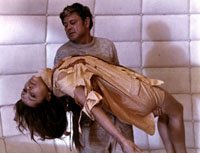
In Tarkovsky's Solaris, Kelvin grasps that Harey is a materialization of his own innermost traumatic fantasies. This accounts for the enigma of strange gaps in Harey's memory - of course she doesn't know everything a "real" person is supposed to know, because she is not such a person, but a mere materialization of HIS fantasmatic image of her in all its inconsistency. The problem is that, precisely because Harey has no substantial identity of her own, she acquires the status of the Real that forever insists and returns to its place: like fire in Lynch's films, she forever "walks with the hero", sticks to him, never lets him go. Harey, this fragile specter, pure semblance, cannot ever be erased - she is "undead", a machine in the ghost/ghost in the machine, eternally recurring in the space between the two deaths.

If these categories seem to have little to do with Derrida's quasi-Marxian analysis of the virtualization of subjectivity and history, they start to overlap in Zizek's analysis of the commodity fetish. While Derrida talks of the fetish as an object which starts to move and is endowed with life in the constitutive moment of haunting [see below], Zizek is able to show how this haunting consists of two opposing tendencies between life and death in "the spectralization of the fetish": in these increasingly virtualized times, "Capital functions as the sublime irrepresentable Thing, present only in its effects, in contrast to a commodity, a particular material object which miraculously 'comes to life,' starts to move as if endowed with an invisible spirit". The horror of virtualized Capital, as Zizek sees it, is not that it might be the machine in the ghost or the ghost in the machine, but that it might be trying to approximate or obliterate the irrepresentable-impossible Real, and in doing so might obliterate the space of fantasy altogether.
Crash-Test Dolls

Zizek's useful distinction between "the machine in the ghost" and "the ghost in the machine" is homologous to what it is that is going on in our cultural responses to technology. As an example, consider - by oblique reference to Cronenberg's Crash - the crash test dummy: here we have an object whose sole purpose is to be put into cars and then smashed up (though preferably not too much). However at the same time, these objects act as weird road-crash fetishes, voodoo dolls of death: they are dressed up, given names, have "family" photos taken, even "speak" to us in commercial advertising. This "haunted" object contains elements of both the machine in the ghost and the ghost in the machine. First, the cultural images we have of the crash test dummy call for it to look and behave as much like a human (including speech) as possible. But if we look at it closely, we find that it is dumb and mechanical. This "machine in the ghost" suggests something quite horrifying that we are not really prepared to admit - what if we are really nothing more than crash test dummies ourselves, "blind contingent devices" whose sole purpose is to be smashed up in high-speed collisions?
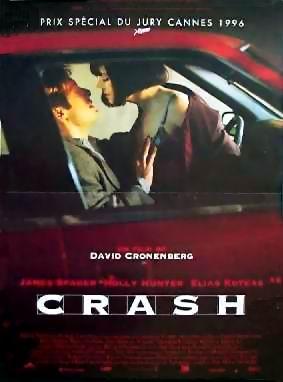
Second, we are quite aware that these bodies are made to be as flesh-like as possible. But we also know that the damage sustained to a crash test dummy is repairable - just take them to the shop for a bit of panel-beating. While the damage to a dummy is supposed to mimic damage done to a human, most of the ways we measure that damage is through pressure sensors and paint explosions to mimic bruises: whole-body trauma of the kind that humans sustain in car crashes is a fragile flesh-thing, a response of the irrepresentable Life-thing to unbearable trauma. And finally, in between these ghosts and machines we have the horrifying space of the death-drive, here quite compellingly trapped in the plastic body literally "driven" to its death: so, for Zizek, "it is only here, where its functioning is suspended, that we fully become aware of the ruthless technological drive which determines our lives". This, for Zizek, is the horror encapsulated in Heidegger's Gestell ("enframing") - the instrumentality of technology turned back on humanity.
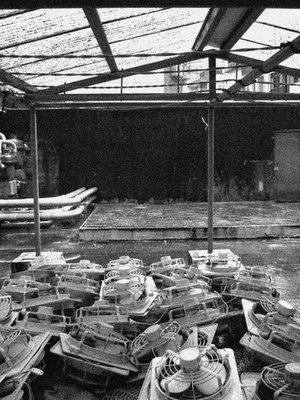
Should we, then, approach the world with an openness towards the quotidian, the signs of everyday life, and through the perspective of one of the key features of capitalism, namely the permanent production of the piles of leftover waste? The obverse of the incessant capitalist drive to produce newer and newer objects are thus the growing piles of useless waste, piled mountains of used cars, computers, etc., like the famous airplane "resting place" in the Mojave desert-in these ever-growing piles of inert, disfunctional 'stuff', which cannot but strike us with their useless, inert presence, one can, as it were, perceive the capitalist drive at rest. One should recall here Benjamin's insight into how we encounter historicity proper precisely when we observe cultural artifacts in decay, in the process of being reclaimed by nature. In November 2003, after a visit to Poland where he participated in the festival Camerimage and opened an exhibition of his own paintings and sculptures in Lodz, film-maker David Lynch was thoroughly fascinated by this truly "post-industrial" city: the big industrial center with most of the steel works and other factories in decay, full of crumbling grey concrete housing developments, with extremely polluted air and water... Lynch wants to invest money to create there his own cinema studio and help transform Lodz into a thriving center of cultural creativity (Peter Weir and Roland Joffe are also linked to this project). Unheimlich Lynch [uheimlinch] emphasized that he "feels very much at home in Poland"-not in the Romantic Poland of Chopin and Solidarity, but precisely in this ecologically ruined Poland of industrial wasteland. This news confirms again Lynch's extraordinary sensitivity on account of which one should be ready to forget his reactionary political statements as well as his ridiculous support for a New Age megalomaniac project of a mega-center for meditation. The postindustrial wasteland of the Second World effectively is the privileged "evental site", the symptomal point out of which one can undermine the totality of today's global capitalism.
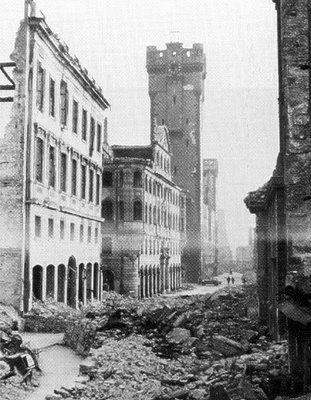
One should LOVE this world, up to its grey decaying buildings and sulphuric smell-all this stands for HISTORY, threatened with erasure between the post-historical First World and pre-historical Third World.
If Stalker is Tarkovsky's masterpiece, it is above all because of the direct physical impact of its texture: the physical background (what T.S.Eliot would have called the "objective correlative") to its metaphysical quest, the landscape of the Zone, is a post-industrial wasteland with wild vegetation growing over abandoned factories, concrete tunnels and railroads full of stale water, and wild overgrowth in which stray cats and dogs wander. Nature and industrial civilization here again overlap, through their common decay - civilization in decay is in the process of again being reclaimed (not by idealized harmonious Nature, but) by nature in decomposition.
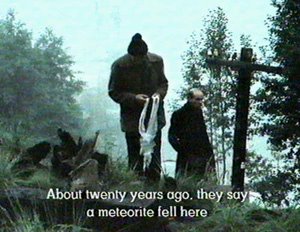
The ultimate Tarkovskian landscape is that of a humid nature, river or pool close to some forest, full of the debris of human artifices (old concrete blocks or pieces of rotten metal). The actors' faces themselves, especially Stalker's, are unique in their blend of ordinary ruggedness, small wounds, dark or white spots and other signs of decay, as if they were all exposed to some poisonous chemical or radioactive substance, as well as irradiating a fundamental naive goodness and trust.

This table has been worn down, exploited, over-exploited, or else set aside, no longer in use, in antique shops or auction rooms. The thing is at once set aside and beside itself. Beside itself because, as we will soon be surprised to see, the s id table is a little mad, weird, unsettled, .“out of joint.” One no longer knows, beneath the hermeneutic patina, what this piece of wood, whose example suddenly looms up, is good for and what it is worth.
Will that which is going to loom up be a mere example? Yes, but the example of a thing, the table, that seems to loom up of itself and to stand all at once on its paws. It is the example of an apparition.

... But if the commodity-form is not, presently, use-value, and even if it is not actually present, it affects in advance the use-value of the wooden table. It affects and bereaves it In advance, like the ghost it will become, but this is precisely where haunting begins. And its time, and the untimeliness of its present, of its being “out of joint.” To haunt does not mean to be present, and it is necessary to introduce haunting into the very construction of a concept. Of every concept, beginning with the concepts of being and time. That is what we would be calling here a hauntology. Ontology opposes it only in a movement of exorcism. Ontology is a conjuration.
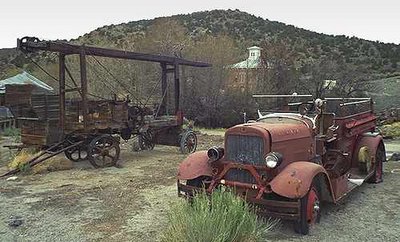
The commodity thus haunts the thing, its spectre is at work in use-value. This haunting displaces itself like an anonymous silhouette or the figure of an extra [figurante] who might be the principal or capital character. It changes places, one no longer knows exactly where it is, it turns, it invades the stage with its moves: there is a step there [il ya lý un pas] and its allure belongs only to this mutant. Marx must have recourse to theatrical language and must describe the apparition of the commodity as a stage entrance (auftritt). And he must describe the table become commodity as a table that turns, to be sure, during a spiritualist sÈance, but also as a ghostly silhouette, the figuration of an actor or a dancer. Theo-anthropological figure of indeterminate sex (Tisch, table, is a masculine noun), the table has feet, the tab e has a head, its body comes alive, it erects its whole self like an institution, it stands up and addresses itself to others, first of all to other commodities, its fellow beings in phantomality, it faces them or opposes them, For the spectre is social, it is even engaged in competition or in a war as soon as it makes its first apparition. Otherwise neither socius, nor conflict, nor desire, nor love, nor peace would be tenable.
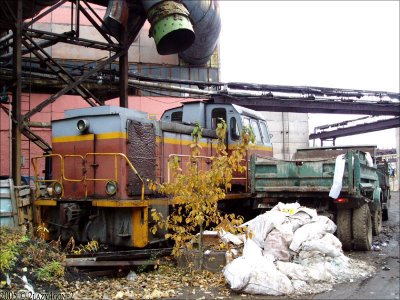
... The capital contradiction does not have to do simply with the incredible conj unction of the sensuous and the supersensible in the same Thing; it is the contradiction of automatic autonomy, mechanical freedom, technical life. Like every thing, from the moment it comes onto the stage of a market, the table resembles a prosthesis of itself. Autonomy and automatism, but automatism of this wooden table that spontaneously puts itself into motion, to be sure, and seems thus to animate, animalise, spiritualise, spiritise itself, but while remaining an artifactual body, a sort of automaton, a puppet, a stiff and mechanical doll whose dance obeys the technical rigidity of a program. Two genres, two generations of movement intersect with each other in it, and that i s why it figures the apparition of a spectre. It accumulates undecidably, in its uncanniness, their contradictory predicates: the inert thing appears suddenly inspired, it is all at once transfixed by a pneuma or a psyche. Become like a living being, the table resembles a prophetic dog that gets up on its four paws, ready to face up to its fellow dogs: an idol would like to make the law. But, inversely, the spirit, soul, or life that animates it remains caught in the opaque and heavy thingness of the bule, in the inert thickness of its ligneous body, and autonomy is no more than the mask of automatism. A mask, indeed a visor that may always be hiding no living gaze beneath the helmet. The automaton mimes the living. The Thing is neither dead nor alive, it is dead and alive at the same time. It survives. At once cunning, inventive, and machine-like, ingenious and unpredictable, this war machine is a theatrical machine, a mekhane. What one has just seen cross the stage is an apparition, a quasi-divinity — fallen from the sky or come out of the earth. But the vision also survives. Its hyperlucidity insists.
... For commodities as Marx is going to point out, do not walk by themselves, they do not go to market on their own in order to meet other commodities. This commerce among things stems from the phantasmagoria. The autonomy lent to commodities corresponds to an anthropomorphic projection. The latter inspires the commodities, it breathes the spirit into them, a human spirit, the spirit of a speech and the spirit of a will.
 Machine in the ghost of aggressive nationalism
Machine in the ghost of aggressive nationalism"That Man is the product of causes which had no prevision of the end they were achieving; that his origin, his growth, his hopes and fears, his loves and his beliefs, are but the outcome of accidental collocations of atoms; that no fire, no heroism, no intensity of thought and feeling, can preserve an individual life beyond the grave; that all the labours of the ages, all the devotion, all the inspiration, all the noonday brightness of human genius, are destined to extinction in the vast death of the solar system, and that the whole temple of Man's achievement must inevitably be buried beneath the debris of a universe in ruins--all these things, if not quite beyond dispute, are yet so nearly certain, that no philosophy which rejects them can hope to stand. Only within the scaffolding of these truths, only on the firm foundation of unyielding despair, can the soul's habitation henceforth be safely built."===>Bertrand Russell, "A Free Man's Worship", 1903. [Thanks to MarK for this century-old reference].


0 Comments:
Post a Comment
<< Home